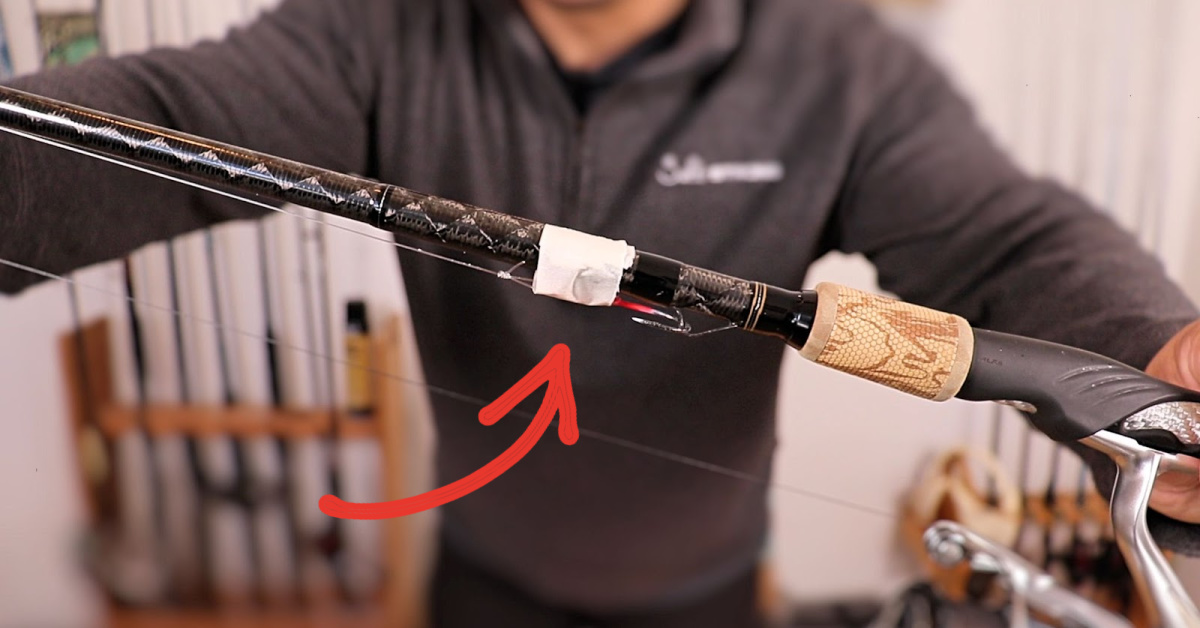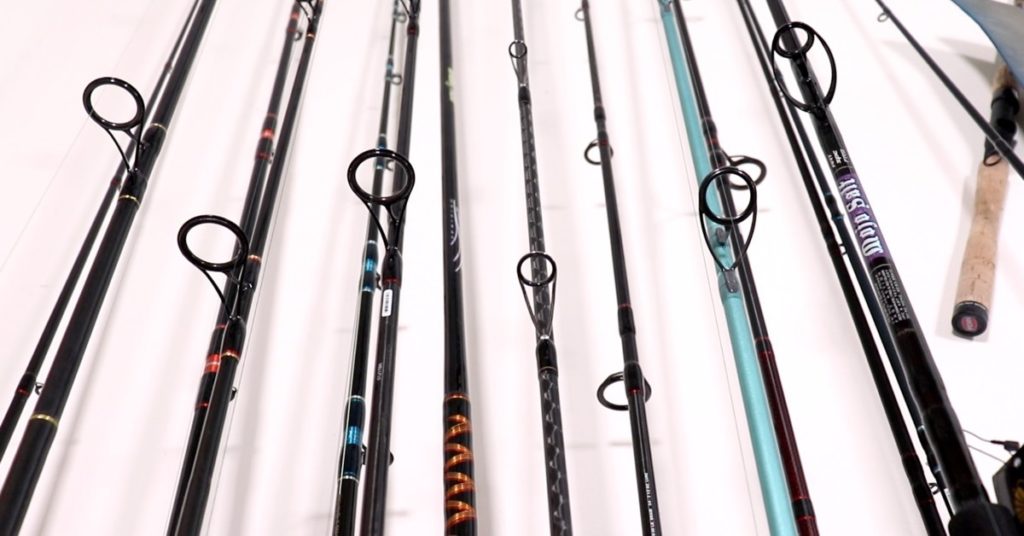How To Protect Your Fishing Rods During Transport
- By: Tony Acevedo
- on
- Found In: *Tackle & Gear, Fishing Tips, Gear and Tips, Rods, Weekly Newsletter: 11-28-21

What is the best way to transport your fishing rods without damaging or breaking them?
Aren’t they durable enough to withstand a few bumps here and there?
Fishing rods are an angler’s best tool and just a small fracture in the rod is all it takes for you to have to fix it or replace it.
Check out more below!!
How To Protect Your Fishing Rods During Transport [VIDEO]

Featured Equipment:
One of the biggest reasons fishing rods break or are damaged is operator error and negligence.
Rods are not meant to be impacted or bumped into anything.
A small collision with an outside object can cause a slight fracture in the rod that creates a weak point.
Moreover, the guides along the rod are very fragile and are not meant to come into contact with anything.
Rod Sleeve
You will benefit from getting a rod sleeve to help protect your valuable fishing rods.
The rod sleeve helps protect the guides during transport.
You most likely have line running through the guides or a couple of rods stacked next to each other when you are traveling to fish.
If you happen to get snagged on the line or it bumps into something, the line can damage or even break the guides by pulling them the wrong way.
A rod sleeve simply slides over your rod from top to bottom like a sock.
It helps protect the guides of your rod and supports against other impacts on the rod.
You should not have rod sleeves on your rods when you are out on a boat.
The sleeve acts as a sail and if the wind catches enough of the sleeve, it will send the rod flying.
If you do choose to still put a sleeve on your rods on a boat, be sure to secure your rods down with a bungee cord or anything to keep them in the rod holders.
The sleeve is excellent for transporting rods in your car particularly well.
It will prevent them from bumping into each other and the lines of multiple rods won’t get tangled up.
Jighead On Hook Keeper During Transport
Another way your rod can be damaged is if you have a jighead or a weighted hook on the hook keeper of the rod.
The jighead will constantly hit against the blank of your rod as you drive down the road or cruise around in your boat.
There is a chance of creating small impact fractures on the blank where the jighead hits against the rod.
An option for you is to wrap some electrical tape just above the hook keeper so the jighead hits against the tape and reduces the impact on the rod.
An alternative to the previous method is to use masking tape or painter’s tape and wrap that around the jighead and rod together.
This way there isn’t any damage to your rods and no sticky residue is left behind.
It is very important to only use this trick during transport and to not leave the tape on your rod for several days.
Conclusion

An angler’s fishing rod is their best tool to fight and handle fish, but all it takes is one slight fracture or damage to severely impact a rod.
Most damage to rods occurs during transport and it is of great importance to take caution when traveling with your fishing rods.
Be sure to take preventative measures to ensure the safety of your fishing rods and gear!
If you have any different or better ways to prevent damage during rod transport, please let me know down below!
And if you know someone who wants to learn more about fishing rod protection, please TAG or SHARE this with them!
P.S. Want access to our best fishing spots and tips, plus discounts to our online tackle store? Click here to join us in the Insider Club!
Related Articles:
Related categories:
STOP WASTING TIME ON THE WATER!
Do what the “SMART ANGLERS” are doing and join the Insider Club.
Here’s what you’ll receive today when you join:
- Weekly fishing reports and TRENDS revealing exactly where you should fish every trip
- Weekly “spot dissection” videos that walk you through all the best spots in your area
- Exclusive fishing tips from the PROS you can’t find anywhere else
- Everything you need to start catching fish more consistently (regardless if you fish out of a boat, kayak, or land).










Tony, all good advice. Thanks. Instead of the tape holding the lure secure, I use a rubber band wrapped around itself and the lure. It holds the lure nicely and no worries about anything sticking to the rod or lure.
Thank you for the great feedback James!
Good video. Also, I slip the point of the hook in the small gap on the front reel seat where the reel slips in that way the jig or lure rest against the handle section in front of the reel.
Good tip! I have done that as well. Only downfall is it doesn’t like to stay put sometimes depending on the size of the hook.
when I think of it, I use the twist ties like on bread bags.
Work great as well in a pinch!
I bought a roll of Velcro I use to secure my gigs. It holds great, comes off fast, can be left on a long time and can be reused. I just cut it to fit as needed
Works great as well! I use velcro and also those rubber gear ties you typically see on the shelves near cash registers at sporting goods and hardware stores.
Thanks, Tony! After watching this, and learning about the rod sleeves, it got me wondering if flexible EPDM rubber pipe insulation slipped over the rod, underneath the sleeve, might provide additional impact protection. Have you ever tried anything like that?
My pleasure Timothy! I haven’t used the pipe insulation, but I have used small pool noodles before. Pretty much the same but I could see the pipe insulation not being as bulky which is nice.
I’ve stopped transporting my rods in the boat rod holders (vertical plastic tubes on either side of the center console) because they were causing cracks in the tubes themselves. I have an SUV (Honda Pilot) and I installed a “Vehicle Rod Saver” that consists of 2 straps that hold up to 7 rods up near the ceiling, out of the way from each other and cargo. I am able to attach them to existing handles so no screws or other hardware needed. It takes a couple of minutes to put all the rods up at the end of a trip but it’s really nice to have them up off the bed where all the gear is. Bass Pro, Amazon carry products like this, very inexpensive.
I like that idea. just found them on eBay for around $10
I concur, I take mine out of the rod holders for transport. The wind puts a lot of strain on the rod, I’ve had hooks pop loose and had braid unspooled, and had a bird hit one and break a pole once. Sleeves work great if you don’t have a way of securing them.
Good stuff Thomas! When trailering a boat it’s not very wise to keep the rods in rod holders as debri from the road could knick a rod, which you won’t realize.
But Shakespeare assures me I can simply throw my beloved Ugly into the back of my ( dirty ) truck…just like in the TV commercial 🙂
Haha, go for it!
At 76 and having fished since I was 3 or 4 I have a total of only 6 rods broken…and no losses so far. i have open fishing rigs here and in Florida, and one enclosed cabin Lake Michigan boat. Here us my solution to protecting all rods regardless of length or size of guides: Golf Tubes large or small slid over the tip of the rod and compressed to fit tightly over the last guide. for larger rods like ocean or lake rods I troll with, I found Fluorescent Light Bulb Protectors tubes work well and can be cut from 8 foot tubes very easily. AND they are a cheap way to protect your valuable rods, even if you raise the tip into a ceiling fan! They are a great pee tube as well for males!
Thanks for your hook eye tips as well…keep your lines tight and you tip up.
Wisconsin Bob
Great tips Bob!
Greets,
Polypropylene mesh slips are my choice.
Don’t catch the wind.
Rinse slips, rods and reels off after marine trips.
Take a cloth slip on a marine trip. Washing machine afterwards.
Leave lines and leaders run through if you must. Wind on leaders are better.
Avoid sticky tape. Lively boat, a major time waster.
Biggest risk is falling on part of your rod.
Probably inevitable.
Don’t buy, learn how to build and repair.
Again, the butts of boat rods will be fallen and trodden on, quite frequently.
Metal reinforced gunwales are a particular hazard.
Personally, I internally reinforce all my butt sections with beech dowel, old school. Treat guides as ephemeral.
Learn how to replace them properly.
Quite satisfying in its own way.
Also facilitates experiments with acid guides.
Remember, 16″ of real Hypalon with 3m cold shrink pulled out on top works wonders. Think rail rods.
Rgds
Great tips Malcolm!
Thank You so much for the valuable tips for rod protection. Have to add the #1 no/no in my opinion for transporting rods is leaving them exposed on the outside of the vehicle. If debris can crack the glass windshield it can easily score your rod blank. I personally never use lure holders on the rod blank as they are usually placed exactly where one picks up rods.
My pleasure Ronald!
Definitely not a good idea! I see people with rod holders on their front bumpers of their vehicles and it makes me cringe as they drive down the rod.